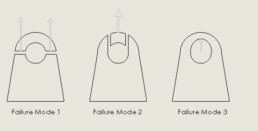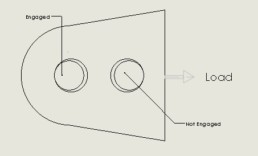Two Pin or Not Two Pin:
The lynch pin of many spreader bar designs is the pin size, or more specifically balancing the thickness of the tube with the diameter of the hole on the inside tube of a telescopic spreader bar. This is always the first calculation I do when I start designing a spreader bar because it is the feature that seems to have the most limitation and sets the course of the design. There is always an internal battle of how to make this more efficient. Bigger holes and subsequently bigger pins allow for higher capacity but are also more expensive and difficult to deal with. So is the question is: Is there a benefit of having two smaller pins verses one large one.
Background on hole failure theory.
There are three basic failure modes for a pin in a hole as show below. Failure mode 1 & 2 are from tearing away the material around the hole mode 3 is elongating the hole and the last would be pin failure. A telescopic spreader bar has a huge amount of material around the hole because of the nature of a hole in a tube so failure mode 1 and 2 don’t really occur. The real failure mode we need to look at is failure mode 3 which is where the bearing load applied to the wall of the lug (or tube) causes the hole to elongate.

Failure mode 3 is important to us because we need to maintain the correct amount of surface area of engagement between the pins and the wall of the lug. If we allow the holes to elongate too much it could cause localized yielding until a catastrophic failure occurs.
Pin Clearance Vs Hole Engagement:
If you can imagine a pin in a hole where the pin is slightly undersized to allow clearance the actual surface area of engagement between the pin and the wall of the lug is dramatically less than you might think. As the system is loaded the steel will flex and overall engagement will go up but the designer needs to balance the need for clearance around the pin so it can be put in and taken out easily with having the correct amount of engagement in order to distribute the stress properly. This is a fairly well studied problem with lots of engineering to back up the industry practices.

The importance of this back ground is that with two pins you potentially have this problem compounded across each one. In theory if all the clearances and tolerances worked out in worst case it could be possible to get yourself into a situation where one pin was carrying all the load and the other wasn’t loaded. This depends on a lot of factors and is something I will go into further depth in a future article but for now lets just be aware of this potential problem with running two pins.

So Why Use Two Pins:
- Increase load capacity if pin material grade or size is limiting factor
- Increase load capacity if bearing surface of inside tube is limiting factor
- stock fewer sizes of pins
- work around if manufacturing process or available machines are limiting available pin sizes
- Use two smaller pins instead of one large pin if the size of the pin is prohibitively big for user.
What is the effect on cost?
So obviously with a two pin system you will need to supply a second pin and cut an extra holes. If we take equivalent strength pins based on simple shear failure mechanism we find that two 1” pins are approximately the same strength as a single 1.5” pin. Based on some recent high tensile pins that I got custom made in quantities of one I paid 17% more for the 1.5” pin over the 1” so using two 1” pins would be 80% more expensive or about a cost of $100. Keeping in mind this is in my geographical region. In my experience if you can source the pins from a volume supplier where they produce the product at a rate where the labor per pin is almost negligible it becomes more expensive to run 1 large pin then 2. However, having said that, I think the lower production companies can benefit from the flexibility offered from using two pins or one as needed to stock fewer pins. In other words, rather than trying to build and stock 1”, 1.25” and 1.5” pins you can just stock 1” and use two of them in the higher load situations. Potentially saving money by reducing the overhead related to keeping the extra parts being in inventory.
Conversely, you can use the idea of using two pins to reduce the required tubing size rather than trying to save money on the pin itself. Typically, the wall thickness off the tube around the load caused by the pin is more of a limiting factor than the buckling factor of the tube itself so you could add an extra pin and reduce the tubing thickness in order to save you total steel weight. For instance decreasing a 4x4x0.25 tube to 4x4x0.19 saves you 2.75 lbs/ft. This cost saving may offset the increased cost from having two pins. This needs to be checked on a case by case basis and again I think the real savings comes from the flexibility of using it in order not have to stock multiple sizes of material.
So in conclusion depending on the situation you can use two pins. I rarely utilize this option because I generally just opt for a larger pin but have a look at what situation works best for your company. If you would like to read about how using two pins can affect stocking material for spreader bars read: Stocking Spreader Bar Material

Good info, and you explain it well.
With our + 50 ton beams, with 6″ pins and up, we use what we call a “key hole” eye. The top haft, about 150 degrees, will be the same diameter as the pin, in the direction of loading, and the bottom 210 degrees to be opened up by machining out material to allow for ease of pin engagement. This allows us to meet clearance requirements. Helps when working with 8″ and up pins, they get heavy, Dennis